

Smart Glasses, Without the Bulky Lenses. For all the hype around smart glasses, none of them actually look like normal glasses.
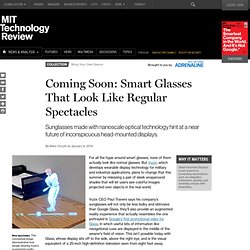
But Vuzix, which develops wearable display technology for military and industrial applications, plans to change that this summer by releasing a pair of sleek wraparound shades that will let users see colorful images projected over objects in the real world. Vuzix CEO Paul Travers says his company’s sunglasses will not only be less bulky and obtrusive than Google Glass, they’ll also provide an augmented reality experience that actually resembles the one portrayed in Google’s first promotional video for Glass, in which useful bits of information like navigational cues are displayed in the middle of the wearer’s field of vision. This isn’t possible today with Glass, whose display sits off to the side, above the right eye, and is the visual equivalent of a 25-inch high-definition television seen from eight feet away. Virtual Retinal Display beams images onto your eyeballs. By Geoff Gasior — 10:22 AM on October 14, 2013 Everyone seems to be pretty excited about the Oculus Rift VR headset.
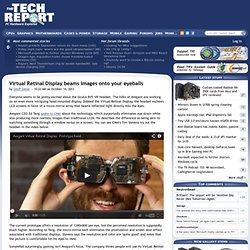
The folks at Avegant are working on an even more intriguing head-mounted display. Dubbed the Virtual Retinal Display, the headset eschews LCD screens in favor of a micro-mirror array that beams reflected light directly into the eyes. Avegant CEO Ed Tang spoke to CNet about the technology, which purportedly eliminates eye strain while also producing more realistic images than traditional LCDs. He describes the difference as being akin to watching something through a window versus on a screen. The current prototype offers a resolution of 1280x800 per eye, but the perceived resolution is supposedly much higher.
Somewhat surprisingly, gaming isn't Avegant's focus. Startup's gesture-based AR glasses closer to Minority Report than Google Glass. A San Francisco startup is challenging Google Glass with an Android-based glasses platform that appears to have more in common with Minority Report-style visions of the future than the tech giant's offering.
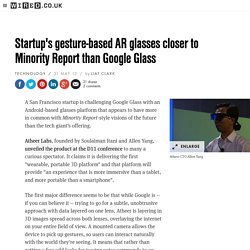
Atheer Labs, founded by Soulaiman Itani and Allen Yang, unveiled the product at the D11 conference to many a curious spectator. It claims it is delivering the first "wearable, portable 3D platform" and that platform will provide "an experience that is more immersive than a tablet, and more portable than a smartphone". The first major difference seems to be that while Google is -- if you can believe it -- trying to go for a subtle, unobtrusive approach with data layered on one lens, Atheer is layering in 3D images spread across both lenses, overlaying the internet on your entire field of view. A mounted camera allows the device to pick up gestures, so users can interact naturally with the world they're seeing. Oculus Rift - Virtual Reality Headset for 3D Games. LED Contact Lenses. LED Lights Make Augmented Vision a Reality Okay, this is just freaky.
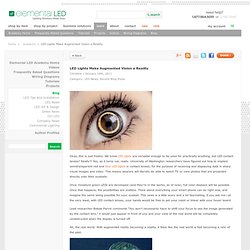
We know LED lights are versatile enough to be used for practically anything, but LED contact lenses? Really?! Yes, as it turns out, really. University of Washington researchers have figured out how to implant semitransparent red and blue LED lights in contact lenses, for the purpose of receiving and displaying data in sharp visual images and video. Once miniature green LEDs are developed (and they’re in the works, as of now), full color displays will be possible. Lead researcher Babak Parvis comments “You won’t necessarily have to shift your focus to see the image generated by the contact lens,” it would just appear in front of you and your view of the real world will be completely unobstructed when the display is turned off. Ah, the real world. Augmented-Reality Contact Lenses. After two decades as an electrical engineer, Randy Sprague quit his job in 2008 to start a solar power company.
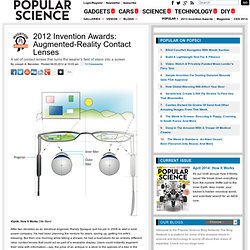
He had been planning the venture for years, saving up, getting his wife's blessing. But then one morning while taking a shower, he had a brainstorm for an entirely different idea: contact lenses that could act as part of a wearable display. Users could instantly augment their view with information—say, the price of an antique in a store or the species of a tree in the forest—or transform their field of vision into a virtual videogame screen.
Glass - How It Feels. Google Begins Testing Its Augmented-Reality Glasses. Photos via GoogleGoogle showed off its first venture into wearable computing, called Project Glass.

If you venture into a coffee shop in the coming months and see someone with a pair of futuristic glasses that look like a prop from “Star Trek,” don’t worry. It’s probably just a Google employee testing the company’s new augmented-reality glasses. On Wednesday, Google gave people a clearer picture of its secret initiative called Project Glass.
The glasses are the company’s first venture into wearable computing. The glasses are not yet for sale. In a post shared on Google Plus, employees in the company laboratory known as Google X, including Babak Parviz, Steve Lee and Sebastian Thrun, asked people for input about the prototype of Project Glass. “We’re sharing this information now because we want to start a conversation and learn from your valuable input,” the three employees wrote. A video released by Google on Wednesday, which can be seen below, showed potential uses for Project Glass. Google Glass update.